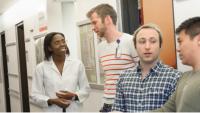Clinical Competence Program

Traditionally, students in the MD/PhD program at Columbia University obtained both degrees, but each course of study was essentially independent of the other. In 2000, the MD/PhD program at Columbia decided to institute a program intended to help integrate the pursuit of the two degrees.
The MD/PhD program is currently structured such that students complete eighteen months of medical school, then participate in two clinical rotations of the major clinical year, study for and take the USMLE Step 1 exam. They then enter a graduate program and choose a lab to work on their PhD. The PhD is expected to take at most 4 years. Students then return to medical school, usually graduating 12-14 months later.
Throughout the PhD lab years, each student meets in a group of MD-PhD students with a faculty member (Dr. William Turner, Dr. Steven Mackey, Dr. Christina Ulane, Dr. Pat Hametz or Dr. Paul Lee) in the hospital. Students obtain patient histories and conduct physical exams with the cooperation of the patients in the hospital and discuss the patient's illness in detail. All students also meet once a month in small groups with their preceptor, reviewing the pathophysiology of some of the diseases and presentations.
In another track of the program, students pick specialty fields of medicine that interest them and are assigned preceptors who work in that field. They meet with that attending physician once per month. Students have accompanied their mentor during office hours, on hospital rounds, in the operating room, at clinical conferences, and at clinical research meetings, thus allowing them to see what the attending's daily schedule as well as providing continuing exposure to patients.
During their last year in the lab, more emphasis is placed on write-ups and presentations. Through these activities, the Clinical Competence course aims to fulfill three main goals:
- By providing continuing exposure to patients, it helps students maintain their clinical skills and fund of knowledge while they are in the lab. The course is structured to make sure they review the most common diseases and complaints, but also gives them the chance to see a wide range of diseases in medicine, neurology, and pediatrics and with their preceptors.
- By giving them experience in different fields of medicine and surgery, it allows them to return to medical school with some idea of which specialty interests them most. They are thus able to plan their third and fourth years of medical school and their residency applications more efficiently.
- Finally, by introducing MD-PhD students to faculty who maintain successful academic careers, the course exposes them to a variety of career paths available to physician scientists. They may meet physicians who run labs, who do clinical research, or who spend a significant part of their time teaching. Thus, they can ask questions about, for example, whether to short track through residency or how to structure a career where it is possible to run a lab and have a fulfilling practice as a physician.